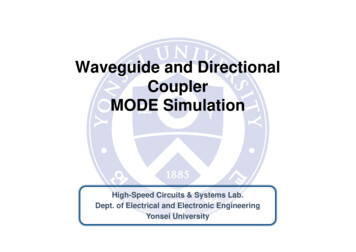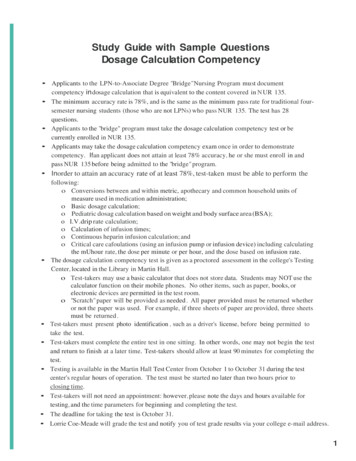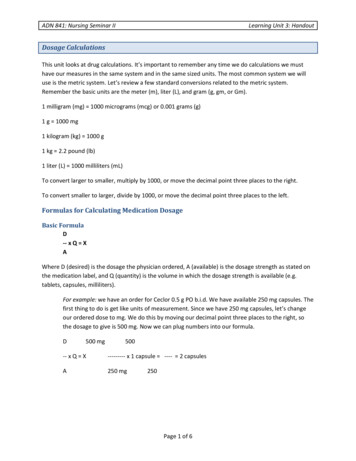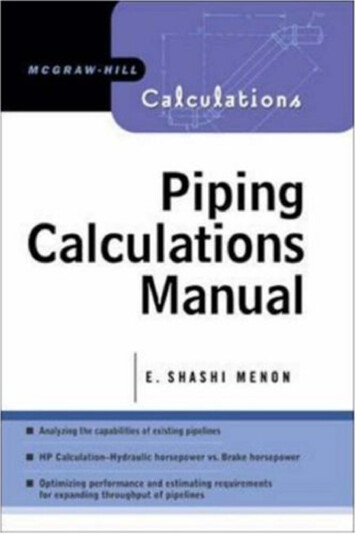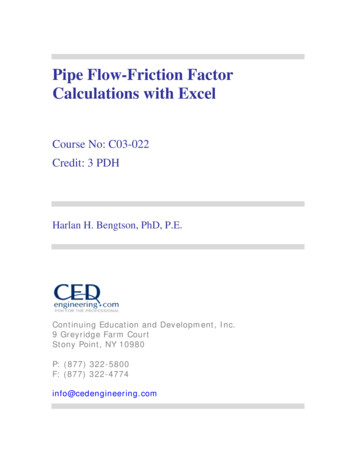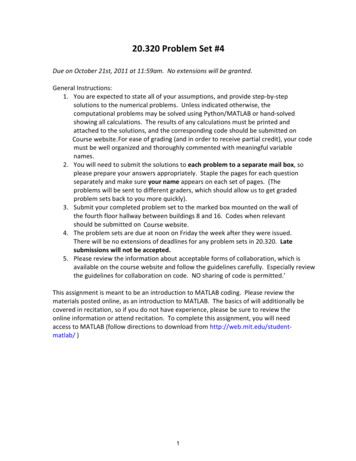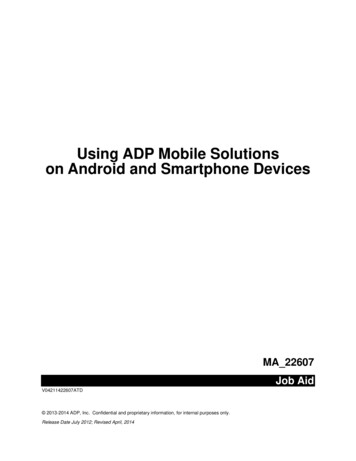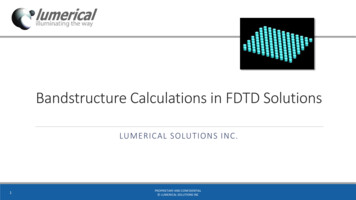
Transcription
Bandstructure Calculations in FDTD SolutionsLUMERICAL SOLUTIONS INC.1PROPRIETARY AND CONFIDENTIAL LUMERICAL SOLUTIONS INC
OutlineIntroductionSimulation methodology Simulation setup AnalysisDemonstration (2D triangular lattice)Simulations with loss Problems associated with loss Tips Example (1D chain of metallic spheres)Q&A2PROPRIETARY AND CONFIDENTIAL LUMERICAL SOLUTIONS INC
Our ProductsSystem/Circuit LevelINTERCONNECTPHOTONIC INTEGRATED CIRCUIT SIMULATORFDTD SolutionsDEVICENANOPHOTONIC SOLVER (2D/3D)CHARGE TRANSPORTSOLVER (2D/3D)spatialdistribution ofcharge carriersMODE Solutionsoptical generationrate of chargecarriersWAVEGUIDE DESIGN ENVIRONMENTComponent Level: Optical Lumerical Solutions, Inc.Component Level: Electrical
Lumerical SolutionsLumerical empowers R&D professionals with best-in-classdesign tools and services to support the creation of betterphotonic technologies Lumerical Solutions, Inc.
IntroductionBandstructure (dispersion) plots can be calculated for structures which haveperiodicity in at least one dimensionUse this information to Find photonic band gaps (frequency ranges where light cannot propagate through the crystalin any direction) Plot Bloch mode profiles Determine loss and group velocity of a photonic crystal waveguide modeband gap6PROPRIETARY AND CONFIDENTIAL LUMERICAL SOLUTIONS INC
Introduction BackgroundBloch vectors, k Represent angles of light propagation withinthe structure All distinct modes of the structure occur forBloch vectors within the first Brillouin zone ofthe reciprocal lattice of the structure Brillouin zone points that we sweep depend onthe type of lattice For more information about determining the Brillouin zonepoints see the text “Photonic Crystals: Molding the Flow of Light”by Joannopolous et al.Simulated Brillouin zones7PROPRIETARY AND CONFIDENTIAL LUMERICAL SOLUTIONS INC
Introduction General MethodUse dipoles to inject energy into the simulation regionRestrict the angle of propagation by using the boundary conditionsLight at frequencies that are not supported by the structure in thepropagation direction will decay quickly while light that gets coupled into amode of the structure will continue to propagate for a longer timeUse time monitors to record the fields over timeBandstructure analysis group performs a Fourier transform analysis todetermine frequencies of modes that are supported by the structure for acertain angle of propagationUse the parameter sweep tool to modify the boundary conditions and sweepover range of propagation angles to get the final plot of band frequenciesversus propagation direction8PROPRIETARY AND CONFIDENTIAL LUMERICAL SOLUTIONS INC
Introduction FDTDFinite Difference Time Domain (FDTD) is a state-of-the-artmethod for solving Maxwell’s equations for complexgeometries Few inherent approximations General technique that can deal with many types of problems Arbitrary complex geometries One simulation gives broadband results Not just for bandstructure calculation, but can also simulate otherdevices such as waveguides, photonic crystal cavities, etc.10PROPRIETARY AND CONFIDENTIAL LUMERICAL SOLUTIONS INC
Simulation Methodology OverviewSimulation setup Parameterization Structure Simulation region Sources and monitorsCalculations Fourier transform Summation of FFTs Sweep over k Collecting results11PROPRIETARY AND CONFIDENTIAL LUMERICAL SOLUTIONS INC
Simulation Methodology SetupDesign parameterization Model analysis group12PROPRIETARY AND CONFIDENTIAL LUMERICAL SOLUTIONS INC
Simulation Methodology SetupDesign parameterization Structure group13PROPRIETARY AND CONFIDENTIAL LUMERICAL SOLUTIONS INC
Simulation Methodology SetupStructure Only necessary to include one unit cell in the simulationfor square, rectangular, body-centered cubic (BCC)lattices Simulate multiple unit cells for non-rectangular latticeseg. Triangular (hexagonal), face-centered cubic (FCC) Pre-made photonic crystal lattice structures can beinserted from the Object Library14PROPRIETARY AND CONFIDENTIAL LUMERICAL SOLUTIONS INC
Simulation Methodology SetupSimulation region Bloch boundary conditions in directions where structure is periodic Band frequencies are determined by setting the Bloch vector, k PML boundary conditions in non-periodic directions withsymmetry to isolate TE/TM modesPMLBlochBlochPML15BlochPROPRIETARY AND CONFIDENTIAL LUMERICAL SOLUTIONS INCPML/PMLor PML/Symm
Simulation Methodology SetupSimulation region for out-of-plane bandstructure Bloch boundary conditions in the out-of-plane directionzyx 2D periodic square lattice shown above 3D simulation region one mesh cell thick in the out-of-plane direction (z-direction) Bloch boundaries in z-direction allows us to set Bloch vector in out-of-plane direction Periodic boundaries in periodic (x and y) directions16PROPRIETARY AND CONFIDENTIAL LUMERICAL SOLUTIONS INC
Simulation Methodology SetupSimulation region for non-rectangular lattices FDTD simulation region is rectangular so for non-rectangularlattices, multiple unit cells can be included in the simulation toform a rectangular unit cell If multiple unit cells of the structure are included in the simulationregion, mesh step size needs to be adjusted to include an integernumber of mesh cells in each unit cell Ensures that each unit cell is meshed the same way17PROPRIETARY AND CONFIDENTIAL LUMERICAL SOLUTIONS INC
Simulation Methodology SetupSimulation region for non-rectangular lattices Example: 2D hexagonal lattice The smallest rectangular unit cell includes 2 unit cells of the hexagonal lattice Lattice constant a ax aXY View ay a*sqrt(3)/2 Set mesh step size in y-direction Dx ax/n Dy ay/mwhere n,m are integersayax18PROPRIETARY AND CONFIDENTIAL LUMERICAL SOLUTIONS INC
Simulation Methodology SetupSources and monitors Randomly positioned cloud of dipoles to excite all modes 1 dipole at a single position and orientation may not excite all of the modes of the devicesince it may be located at a node position where energy will not couple into the mode Several randomly positioned time monitors collect fields over time19PROPRIETARY AND CONFIDENTIAL LUMERICAL SOLUTIONS INC
Simulation Methodology SetupSources for non-rectangular lattices Matched dipoles in each unit cell of the structure inside simulationregion (for non-rectangular lattices) Phase matching condition 180 k rwhereΔθ phase offset from reference dipole k simulation wave vector Δ r position offset from reference dipole20PROPRIETARY AND CONFIDENTIAL LUMERICAL SOLUTIONS INC
Simulation Methodology SetupDipole cloud analysis group Insert from Object Library Specify lattice type and period as an inputvariables Setup script automatically sets up randomlypositioned and oriented dipoles Matching dipoles are set up automatically fornon-rectangular lattice types21PROPRIETARY AND CONFIDENTIAL LUMERICAL SOLUTIONS INC
Simulation Methodology SetupSummary of setup method Parameterize using Model analysis group and structure groups Use Bloch boundaries in periodic directions Random cloud of dipoles and monitors Rectangular lattices Only need to include 1 unit cell in the simulation region Non-rectangular lattices Include multiple unit cells that form the smallest rectangular unit cell Each unit cell should be meshed the same way Matching dipole positions in each unit cell with phase matching22PROPRIETARY AND CONFIDENTIAL LUMERICAL SOLUTIONS INC
Simulation Methodology CalculationsOverview of calculation:Step 1 – Fourier transform to get spectrumStep 2 – Summation of spectraStep 3 – Repeat for all kStep 4 – Collect sweep results, find resonances23PROPRIETARY AND CONFIDENTIAL LUMERICAL SOLUTIONS INC
Simulation Methodology CalculationsFourier transform Apply apodization to filter out start and end effects Applies Gaussian windowing function to the time domain fields to exclude transient fields Apodization parameters are set in the bandstructure analysis group Apply Fast Fourier transform (FFT) to apodized time signal to get thespectrum24PROPRIETARY AND CONFIDENTIAL LUMERICAL SOLUTIONS INC
Simulation Methodology CalculationsSummation of spectra Sum the Fourier transformed time signals from each fieldcomponent of each time monitor Summing over several monitors ensures that all resonantfrequencies are found even if one monitors is located in a node ofa particular modeFourier transform and summation are done using thebanstructure analysis group which can be inserted from theObject Library25PROPRIETARY AND CONFIDENTIAL LUMERICAL SOLUTIONS INC
Simulation Methodology CalculationsBandstructure analysis group Insert from Object Library Contains cloud of time monitors Set apodizations parameters Calculation spectrum Gets field component from each time monitor Applies apodization to the time signal based on input parameters Takes Fourier transform Sums results from each monitor Returns a dataset called “spectrum” which includes the spectrumdata and corresponding vector of frequencies26PROPRIETARY AND CONFIDENTIAL LUMERICAL SOLUTIONS INC
Simulation Methodology CalculationsRepeat for all k One simulation provides thespectrum for a single Blochvector Use the parameter sweeptool to run simulations overa range of Bloch vectors andcollect the spectrum resultfor each simulation27PROPRIETARY AND CONFIDENTIAL LUMERICAL SOLUTIONS INC
Simulation Methodology CalculationsConcurrent computing Parameter sweeps require running many simulations Send them to many different workstations Each workstation can run in distributed computing mode using all coresN computers means you canget your parameter sweepresults N times faster!28PROPRIETARY AND CONFIDENTIAL LUMERICAL SOLUTIONS INC
Simulation Methodology CalculationsCollect sweep results, find resonances Using a script file, collect the spectrum results from the parameter sweep e optics pc bandstructure.html Directly plot the spectrum for all k Find locations of resonant peaks to plot band diagram Set number of bands to look for and the tolerance in the script file settings29PROPRIETARY AND CONFIDENTIAL LUMERICAL SOLUTIONS INC
Simulation Methodology CalculationsSet number bands to look for and toleranceCollect sweep resultsPlot spectrum versus Bloch vectorLoop over each Bloch vector and look forpeaks in the spectrumPlot extracted bandstructure result30PROPRIETARY AND CONFIDENTIAL LUMERICAL SOLUTIONS INC
Simulation Methodology CalculationsSummary of calculation methodology: Apply apodization to time signalsPerformed by Fourier transform apodized time signal to get spectrum bandstructureanalysis group Sum spectra from each monitor Run parameter sweep over a range of Bloch vectors Collect spectrum result from each point in the sweep Find peaks in the spectrum at each k to get bandstructure diagram31PROPRIETARY AND CONFIDENTIAL LUMERICAL SOLUTIONS INC
Example 2D Hexagonal LatticeHexagonal (triangular) lattice of index n 1 circles with background index n 2Simulation region covers 2 unit cellsMatching dipoles in each unit cell with phase offsetTE or TM modes excited based on dipole orientationScript file collects sweep results, extracts and plots bandstructureTM case32PROPRIETARY AND CONFIDENTIAL LUMERICAL SOLUTIONS INCTE case
Simulations With LossProblems associated with lossTips for lossy simulations Source and monitor placement Apodization settings Symmetry boundary conditions Source spectrum ToleranceParticle chain example33PROPRIETARY AND CONFIDENTIAL LUMERICAL SOLUTIONS INC
Simulations With Loss Problems AssociatedSources of loss Absorbing materials RadiationProblems associated with loss Resonant fields decay quickly Useful part of the time signal is shortened Fourier transform of time signal is noisy Difficult to extract resonant peaksWith more deliberate setup, we can increase the strength of thesignal from modes that we are interested in and decrease thesignal from other modes and noise so we can more easilyextract a clear bandstructure diagram34PROPRIETARY AND CONFIDENTIAL LUMERICAL SOLUTIONS INC
Simulations With Loss TipsSource and monitor placement Place source in an area where you expect fields to be strong forthe mode or modes you are interested inPlace sources and monitors Similar placement of monitorsin strong modal field regions35PROPRIETARY AND CONFIDENTIAL LUMERICAL SOLUTIONS INC
Simulations With Loss TipsApodization settings Modify the center and width of the apodization window These settings can be found in the bandstructure analysis group Use a movie monitor to help determine the time and duration of theresonanceSignal does not decay by the end of thesimulation so any portion of signal is okay36Strength of signal from mode of interest maybe strongest in this particular stretch of timePROPRIETARY AND CONFIDENTIAL LUMERICAL SOLUTIONS INC
Simulations With Loss TipsSymmetry Use symmetric/anti-symmetry boundary conditions to isolatemodes of interest37PROPRIETARY AND CONFIDENTIAL LUMERICAL SOLUTIONS INC
Simulations With Loss TipsSource spectrum A broadband source pulse isused by default Modify the source centerfrequency and bandwidth tooverlap with the expectedfrequency of the bands so moreenergy is coupled into themodes of interest38PROPRIETARY AND CONFIDENTIAL LUMERICAL SOLUTIONS INC
Simulations With Loss TipsTolerance Peaks in spectrum with heights below tolerance are not included in theextracted bandstructure plot In other words, peak height must be larger thantolerance*(max peak height) Lower value of tolerance if bands can be seen clearly in the plot of fs vsk before the bandstructure plot is extracted39PROPRIETARY AND CONFIDENTIAL LUMERICAL SOLUTIONS INC
Example Particle Chain1D chain of gold spheres periodic along x-axisGoal is to plot the ban
Introduction FDTD Finite Difference Time Domain (FDTD) is a state-of-the-art method for solving Maxwell’s equations for complex geometries Few inherent approximations General technique that can deal with many types of problems Arbitrary complex geometries One simulation gives broadband results
